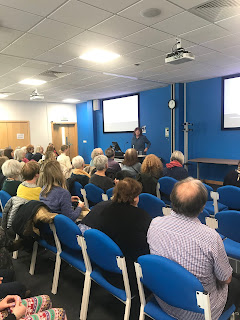The English programme at UCS began in 2015 and developed from strength to strength over the next few years. As programme leader at the time, I wondered how we could find a way of celebrating the wonderful experience of studying literature next to the banks of the River Severn and close to Charles Darwin's childhood home. I'd been involved in a community quilt project before, but only as an observer, rather than a participant. I thought it would be a challenge for me, my colleagues, and the students on the programme to create a large textile banner as a permanent memorial of our first years of working and studying together. None of us were expert with the needle but we all were keen to create something which reflected an aspect of ourselves, our love of literature and our appreciation of being in the lovely town of Shrewsbury. Despite a few qualms about our skills, we all decided to give it a go!
The result is 17 different 'textile stories' which have been expertly brought together in a banner by the virtuoso sewist, Elaine Rowland. Here are the various stages of her careful construction of disparate textile squares into a beautiful whole:
Finding a possible layout
The blocks are attached to the backing fabric
The completed banner. Elaine kindly created a centrepiece which helps explain the rationale for this banner:
Elaine created an image of books and a mug sewn onto a piece of fabric with piles of books in the background. In the finished version she added the words 'University Centre Shrewsbury' in gold thread to the spine of the red book.
We held a special 'unveiling' event on 31st October 2019 to celebrate this symbol of our sense of community:
Deborah Wynne and Elaine Rowland holding the finished banner.
Philip Jones decided to create a block based on the texts he's enjoyed studying. He said, 'This quilt square represents three years of studying literature and young adult fiction in the most wonderful of company. Depicting: the time-keeping rabbit from Alice's Adventures in Wonderland to keep us punctual, the fruits of our labour from 'Goblin Market', symbols from the Gothic novels that we remember, and the treasure from Treasure island, to symbolise the prosperity desired for everyone, and all enclosed within the House colours of Harry Potter to make the magic happen.'
Medeni Evens created an image of the Guildhall and St Chad's Church in Shrewsbury, with a daffodil representing Wales, where she lived.
other contributors explained the stories behind their blocks. Naomi Walker said, 'My square represents a map of Shrewsbury as PhD thesis is about the two Shropshire writers, Mary Cholmondeley and mary Webb, and how place is represented in their writing. I use G.I.S. mapping in my research and I wanted to demonstrate the importance of maps in my textile square.'
Dr Giulia Miller, who teaches literature and film at UCS, said that her 'square represents a particularly busy but wonderful term, when I was commuting several times a week, taking both the bus and the train. One morning, whilst on the bus, I spotted an owl and was very excited. my daughter Noa was also excited and loves arts and crafts, hence her contribution.'
Student Chloe Norton explains, 'My quilt square is a simple 'tribute' to the novels that fully sparked commy love for literature - The Hunger Games series. The mockingjay is a symbol of change, reflecting my journey through 3 years of studying and onto the next chapter of life.' Andie MacDonald, who graduated in 2019, said that 'This vibrant red tartan reflects my proud Scottish heritage, and represents the bloodshed of the MacDonald clan at Glencoe from the murderous scunne Campbell. The font is ironic; McDonald's restaurants use the same font and name is constantly misspelled! The peace sign is ubiquitous and timeless.'
Dr Lucy Andrew, the current English programme leader, has created a block reflecting her research interests in Harry Potter, while I created a pile of books by the nineteenth-century authors I love most, as well as including a bee to reflect the meaning of my name 'Deborah'.
Elaine Rowland has explained her role in the making of the banner on her blog, which you may wish to read: http://blacktulipsewing.blogspot.com/2019/11/the-university-centre-shrewsbury-banner.html
Many thanks to Elaine for all her hard work and for letting me use her photographs for this blog post.

















